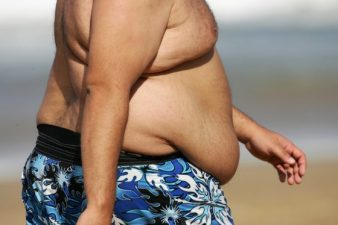Born in an economic boom, kids in oil-rich Arab Gulf States use their silver spoons to up caloric intact.
Blame laziness, love of Western brands, or ample disposable income, but children across the Gulf region are getting fatter. Recent studies tag 20 percent of children in Dubai as overweight, and another 12% as obese. Their Gulf nations’ cousins in Saudi Arabia, Bahrain, Oman and Qatar are just as hefty.
The core lifestyle of the world’s urban children, zip code be damned, is numbingly similar. Conditioned living spaces and electronic entertainments encourage an increasingy sedentary lifestyle. Children in the Gulf are nothing like their nimble agrarian ancestors. Informal exercise is all but extinct. Internet-based social networking brings the playdate indoors. Besides, public parks and sports fields are hard to find in modern Gulf cities.
Why sweat outside with friends when you can sit in air-conditioned comfort and Skype and Facebook for hours? Have mom order in a pizza or a bag of cheeseburgers while you’re at it. You’re living the fatty-Emirati Dream.
Folks are fast to pin it on “American Eating” – a phenomenon I first heard of when I moved to Ireland. The Irish and Brits are quick to blame their obesity on American fast-food (conveniently ignoring their starch-based home cuisines and epic alcohol consumption).
In the Middle East, fast-food living arrived about ten years ago. Western franchises are wildly popular; proving the power of advertising. But the food is awful and, outside the USA, it’s not cheap. No denying that my fat homeland has exported its Twentieth Century fast-food values to the rest of the world. But I object to American junk food being the only cause of this tubbydemic.
Washing down falafel sandwiches and shawarma with sugar-laden tea is as belly-building as anything Mayor McCheese has on offer.
Money’s not an object in most Gulf Cooperation Council (GCC) nations.
Parents here aren’t ideal role models: over 50% of Gulf men and 70% of Gulf women are overweight or obese. The adults who are employed have jobs requiring miniscule physical exertion. Most GCC countries use oil revenues to provide citizens with reduced rates for the basics like rent and energy, or outright cash payments, leaving families with more money to indulge in convenience.
Home cooking is history when families can eat out easily and affordably several times a week.
Scientists estimate that global obesity among children will rise substantially over the next few years. Presently, 60% of all children living in North and South America are overweight; 38% of EU kids similarly tip the scales. The numbers of overweight kids in the Middle East and Asia are rapidly swelling.
Environmental conditions are squashing poor diet as a predominant root of disease.
Quick urbanization of Arab Gulf states exposes kids to increased air and water pollution. New planned housing communities provide inadequate space for safe, informal, outdoor play. Ubiquitous passive smoking further jeopardizes their health. And everyone is in cars.
World Heart Federation data suggests that over 66% of the Saudi population is physically inactive and about 25% of those adults are smokers. (Organized sports are not an option for the Kingdom’s females.) The same study shows 63% of Kuwaitis are couch potatoes, trailed by 58% of Emiratis and 47% of Lebanese.
Add it up, and kids in the Gulf region are at greater risk of developing cardiovascular diseases (CVD) than kids in other Arab states, says the World Heart Federation. Overweight kids often become obese adults who’ll face a menu of significant health issues including heart disease, diabetes and hypertension, and obesity-related cancers, including breast and bowel cancer.
Statistics from Syria indicate 3,000 new cases of child coronary heart disease arise annually among the country’s 20 million residents. According to the World Heart Federation, only a third receives the necessary treatment. Cairo’s National Heart Institute reports approximately 9,000 new cases of CVD annually in Egypt, half of them requiring surgery.
Catch that distinction? These stats are for the children.
At the same time, children on the opposite end of the Arab economic scale face severe malnutrition, ironically another critical risk factor for CVD. Yemen has the second highest rate of chronic malnutrition among children in the world. And in Egypt, 6.8% of children under five are malnourished. Political strife in Syria and Palestine disrupts food supplies. Rich or poor, turbulent or peaceful, these modern realities are hurting the hearts or our children.
Help kids from falling into the eating disorder trap?
With western medicine having a few decades’ head-start, there are some practical and proven remedies:
1. Separate your child’s self-worth from their physical appearance.
2. Become a positive ‘healthy body image’ role model.
3. Balance the constant media barrage by talking to your kids.
4. Tell them what they see in ads is not achievable.
5. Teach that all food is good food in moderation.
6. Don’t skip meals.
7. Become an active family.
8. Eat together, and not on-the-go.
Maybe even cook together?
Good health: it’s the game the whole family can play.
Photo of fat Middle Eastern boy from Shutterstock




